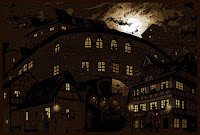Crypts, cave systems, sewers, abandoned castles. The
traditional dungeon crawl seems to be getting a bad rap recently. But why is it
okay to continue having the exploration of these contained spaces, usually full
of monsters, remain a central part of the modern RPG?
Many people think that most players view killing creatures
as the quickest way to gaining power. They see these dungeons, full of
adversaries, as just another method for these murderhobos to get their
monster-slaying jollies. The truth is, you can make it through a dungeon
without killing a large portion of its inhabitants—if you, as the DM, give your
players creatures to negotiate with.
I've been running one of Paizo's adventure paths for my
group for the past two years. Like most canned adventures, it has a lot of RP
possibilities built into the towns, cities, and villages that the players start
and end in; which ends up bookending dungeon runs. In the second book of this
AP there was one giant multi-level dungeon in which players had to delve.
Although there were combats, the players also found instances where they were
able to negotiate past a few battles. Because they were good aligned, they
ended up dealing mostly non-lethal damage to and taking prisoner most sentient
humanoid creatures instead of killing them.
One of the other major problems people have with dungeon
crawls is not that they tend to be rooms strung together with combat
situations, but these combats can take an inordinate amount of time to run. It
bothers some gamers that a week’s worth of in-game RP, investigation, and
character development may take one gaming session. Meanwhile the combats in a
dungeon delve that takes in-game one or two days can take real-time up to two
or three sessions.
This isn't an easy problem to solve. The system inherently
has more rules for combat because RP doesn't actually require that many rules.
I don't need rules to know how to speak in character or affect an accent.
Combat, however, has so many nuances and rules were designed so it doesn't
devolve into childhood sessions of "I hit you." "Oh no you
didn't." The rules intended to keep combat fair and balanced also make
combat more time consuming.
There are ways to streamline D&D and Pathfinder combat.
Pathfinder Unchained outlines a number of ways to reduce the actions
people get during combat, although some of it comes down to GM and player
preparedness. Having your action ready for your turn and the GM knowing all of
the monsters’ abilities can help move combat along pretty quickly.
That said, Dungeons and Dragons and by extension Pathfinder
has always been a game of dungeon crawls with combats. Looking back at modules
from first and second edition you can see that modern modules follow the same
formula these old modules had, of large RP sessions in a town punctuated by
long dungeon crawls. This is nothing new. Claims that this wasn't the way
gaming was back then and that video game culture has somehow made it this way
is denying gaming's true past and looking back at it through rose-colored
glasses.
That doesn't mean that there aren't ways to game that are
less punctuated with these large dungeons. There are many other systems that
make social interaction and role playing their central or only focus.
Pathfinder and D&D are not those games, however and to think they
should be is disingenuous to their history. Pathfinder's system works as
intended. Claims that it is broken because it doesn't do something as well as
games that are geared to do that specific thing is like whining a wrench is broken
because it can't remove a Phillips head screw. There are many different ways to
game and you need the right tool for the right job.
All in all, I enjoy the dungeon crawl, which is why I enjoy
Pathfinder as a system. It has begun to incorporate more and more avenues for
in-game social interaction. The new book, Ultimate Intrigue, attempts to
deal with the idea of social combat as well as outlining ways to write
adventures that are more roleplay oriented than your standard dungeon delve.
Although it will probably never be the best system for this job, it can still
get the job done to some degree.
How have you explored social interaction in Pathfinder or
D&D? What systems do you prefer, if others, for less combat oriented games?
Are you a fan of the traditional dungeon crawl?
The CRB is a labor of love but also a second full-time job.
Content blogs rely on the people who enjoy them to keep making it viable to put
out that content. Please consider becoming a patron of the CRB
today for as little as $1. For more from me and my thoughts on gaming, check
the CRB out on Twitter where I live tweet my weekend games. The CRB is
also on Tumblr where I post some great and inspiring fantasy art as well
as large commentary about my gaming experiences. Become a part of the CRB
family on Facebook. If you’d like to receive the CRB right when it posts,
try out Kindle Subscriptions which will push the CRB right to your
Kindle.





No comments:
Post a Comment